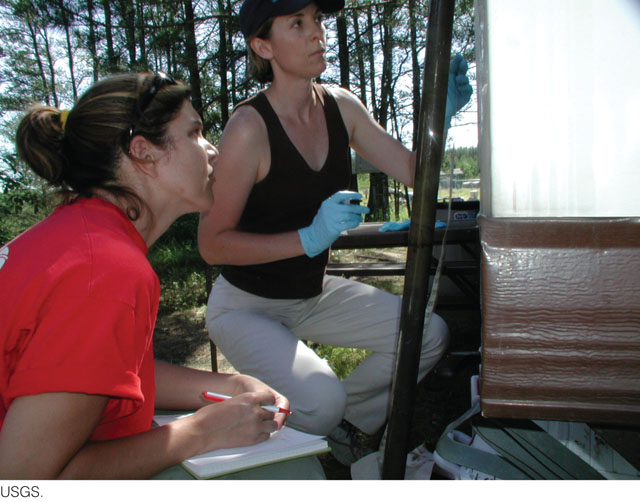The Scientific Method
The term geology (from the Greek words for “Earth” and “knowledge”) was coined by scientific philosophers more than 200 years ago to describe the study of rock formations and fossils. Through careful observations and reasoning, their successors developed the theories of biological evolution, continental drift, and plate tectonics—major topics of this textbook. Today, geology identifies the branch of Earth science that studies all aspects of the planet: its history, its composition and internal structure, and its surface features.
The goal of geology—and of science in general—is to explain the physical universe. Scientists believe that physical events have physical explanations, even if they may be beyond our present capacity to understand them. The scientific method, on which all scientists rely, is the general procedure for discovering how the universe works through systematic observations and experiments. Using the scientific method to make new discoveries and to confirm old ones is the process of scientific research (Figure 1.1).

When scientists propose a hypothesis—a tentative explanation based on data collected through observations and experiments—they present it to the community of scientists for criticism and repeated testing. A hypothesis is supported if it explains new data or predicts the outcome of new experiments. A hypothesis that is confirmed by other scientists gains credibility.
Here are four interesting scientific hypotheses we will encounter in this textbook:
 Earth is billions of years old.
Earth is billions of years old. Coal is a rock formed from dead plants.
Coal is a rock formed from dead plants. Earthquakes are caused by the breaking of rocks along geologic faults.
Earthquakes are caused by the breaking of rocks along geologic faults. The burning of fossil fuels is causing global warming.
The burning of fossil fuels is causing global warming.
The first hypothesis agrees with the ages of thousands of ancient rocks as measured by precise laboratory techniques, and the next two hypotheses have also been confirmed by many independent observations. The fourth hypothesis has been more controversial, though so many new data support it that most scientists now accept it as true (see Chapters 15 and 23).
A coherent set of hypotheses that explains some aspect of nature constitutes a theory. Good theories are supported by substantial bodies of data and have survived repeated challenges. They usually obey physical laws, general principles about how the universe works that can be applied in almost every situation, such as Newton’s law of gravity.
Some hypotheses and theories have been so extensively tested that all scientists accept them as true, at least to a good approximation. For instance, the theory that Earth is nearly spherical, which follows from Newton’s law of gravity, is supported by so much experience and direct evidence (ask any astronaut) that we take it to be a fact. The longer a theory holds up to all scientific challenges, the more confidently it is held.
5
Yet theories can never be considered completely proved. The essence of science is that no explanation, no matter how believable or appealing, is closed to questioning. If convincing new evidence indicates that a theory is wrong, scientists will discard it or modify it to account for the data. A theory, like a hypothesis, must always be testable; any proposal about the universe that cannot be evaluated by observing the natural world should not be called a scientific theory.
For scientists engaged in research, the most interesting hypotheses are often the most controversial, rather than the most widely accepted. The hypothesis that fossil-fuel burning causes global warming has been widely debated. Because the long-term predictions of this hypothesis are so important, many Earth scientists are now vigorously testing it.
Knowledge based on many hypotheses and theories can be used to create a scientific model—a precise representation of how a natural process operates or how a natural system behaves. Scientists combine related ideas in a model to test the consistency of their knowledge and to make predictions. Like a good hypothesis or theory, a good model makes predictions that agree with observations.
A scientific model is often formulated as a computer program that simulates the behavior of a natural system through numerical calculations. The forecast of rain or sunshine you may see on TV tonight comes from a computer model of the weather. A computer can be programmed to simulate geologic phenomena that are too big to replicate in a laboratory or that operate over periods of time that are too long for humans to observe. For example, models used for predicting weather have been extended to predict climate changes decades into the future.
To encourage discussion of their ideas, scientists share those ideas and the data on which they are based. They present their findings at professional meetings, publish them in professional journals, and explain them in informal conversations with colleagues. Scientists learn from one another’s work as well as from the discoveries of the past. Most of the great concepts of science, whether they emerge as a flash of insight or in the course of painstaking analysis, result from untold numbers of such interactions. Albert Einstein put it this way: “In science… the work of the individual is so bound up with that of his scientific predecessors and contemporaries that it appears almost as an impersonal product of his generation.”
Because such free intellectual exchange can be subject to abuses, a code of ethics has evolved among scientists. Scientists must acknowledge the contributions of all others on whose work they have drawn. They must not falsify data, use the work of others without recognizing them, or be otherwise deceitful in their work. They must also accept responsibility for training the next generation of researchers and teachers. These principles are supported by the basic values of scientific cooperation, which a president of the National Academy of Sciences, Bruce Alberts, has aptly described as “honesty, generosity, a respect for evidence, openness to all ideas and opinions.”